I’m not going to lie. My first time paddling was a terrible nightmare. I was on a man-made lake that went into the Black Sea.
The water in the channel moved from side to side as boats carrying tourists went through it. This is how people leave the lake and get to the sea.
I was thinking a lot of scary things that could happen. The pain in my chest made my heart beat so fast that I could almost hear myself screaming for help. It was awful. When I got to smoother water, though, everything changed.
My feelings about kayaking have changed, and I’ve started to feel the peace that the sea gives off, drop by drop.
Some Love and Some Hate
I guess you could say that a mix of love and hate drove me to start paddling. At this point, the anger has gone away, and I can now fully enjoy every kayaking trip.
That being said, I know that this activity is very relaxing for a lot of people from all over the world, not just me.
It only makes sense that we talk a little about how we can repay the kayak that has taken us on so many trips and through so many beautiful places.
One way we could do this is by putting our kayak away in a way that will make sure it stays in our lives for a very long time. Let’s find out how to put a boat away.
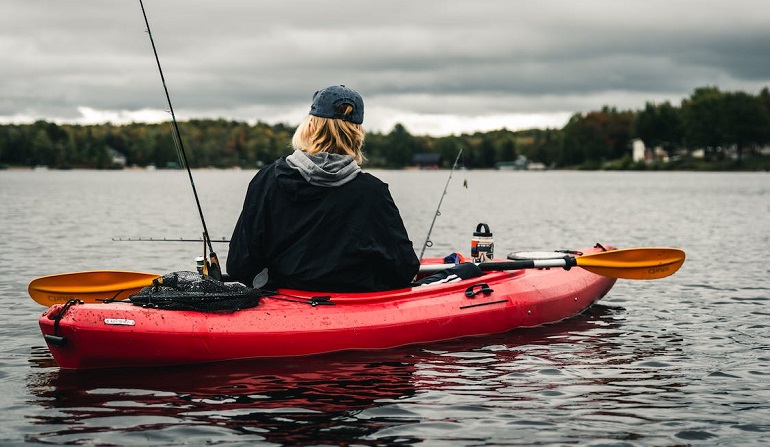
How to Keep Your Kayak Safe
Some people think that taking care of and storing boats properly is not as important as keeping them in good shape. This is not at all what it seems to be.
If you store your kayak wrong, it will get damaged, which could cost a lot to fix or, even worse, you could lose your beloved kayak.
It is very important to know how to store your kayak correctly when you’re not using it. This will keep it in great shape and make sure that it lasts as long as possible without needing expensive fixes.
If you like to kayak inside or outside, there are some things you should know about how to store your kayak. These are like rules for a boat that will last a long time. Of course, things are easier if you like inflatable boats.
1. Moisture
Something else that can damage your boat is water. Too much water could cause mold to grow and weaken the kayak’s body material.
If you want to store your boat, try to do so in a dry, well-ventilated area. Put it under a tarp or cover if you have to store it outside. It’s also best to bring the boat inside during heavy rain so that water doesn’t damage it.
2. Sunlight
Shiny things can hurt the surface of your boat, its deck, and things that are easily broken. Another thing is that too much sun can fade or even crack the boat cover.
Additionally, sunshine may bend the kayak, which means that the next time you take it out, it will not be straight.
So, if you keep your kayak outside, make sure it doesn’t get full sunlight.
3. Heat
You should keep your kayak away from radiators, fires, and other heat sources if you have to store it inside. These will damage the wood. Even if you have a plastic boat, you shouldn’t be near a heat source because the plastic will get damaged. Keep your kayak away from places that are very hot.
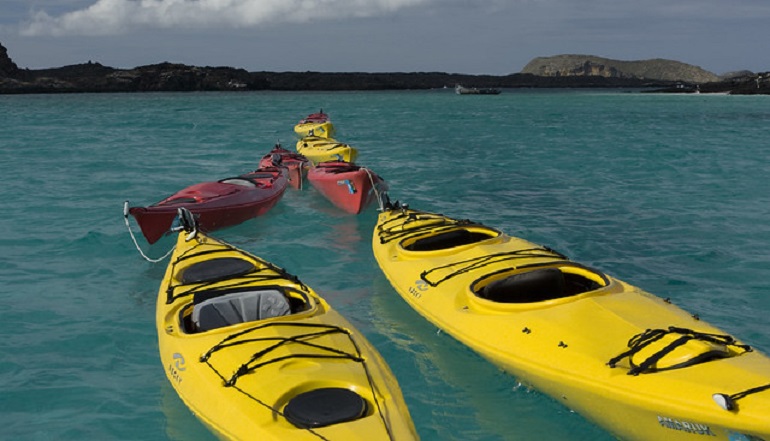
4. Cold
Cold temperatures can also crack a hull if they’re allowed to get too cold too fast (think freezing rain). The best way to prevent this is by storing your kayak in a warm, dry place.
If you need to store it outside, try bringing it inside during cold winter months and putting down plastic sheeting or tarps over it.
5. Clean the kayak very well.
Your boat can’t go straight from the water to where you store it. To be honest, this great gear deserves some extra care, don’t you agree?
You need to do two important things before you put your kayak away because you want to take good care of it:
Use soap and warm water to get rid of all the dirt. Use a rag or paper towel to dry any wet spots.
To be more specific, use warm water and a mild soap to clean your boat. Make sure it’s completely dry before putting it away.
Get all the water out of your kayak before putting it away by using compressed air or a hand-held vacuum cleaner. However, you don’t have to do this if you don’t have either of these tools. Mild soap, warm water, and some paper towels are all you need to keep it simple.
6. Find a place to keep the kayak.
Congratulations, you now know how to properly store your kayak and what you need to do before putting it away. Let’s talk about where to store a kayak in the best way.
Where to store your kayak is the first thing you need to decide. What you do will depend on whether you want to store your boat outside or inside.
If you live in a place where winters are hard and there is a lot of snow, you should keep the boat inside. This will keep it from getting damaged by freezing temperatures, like cracking.
If you live in a warmer area where rain or sun can be a problem, storing it outside is better because it can help stop mold growing inside, which could damage the finish of your boat over time.
But let’s talk more about each choice you have.
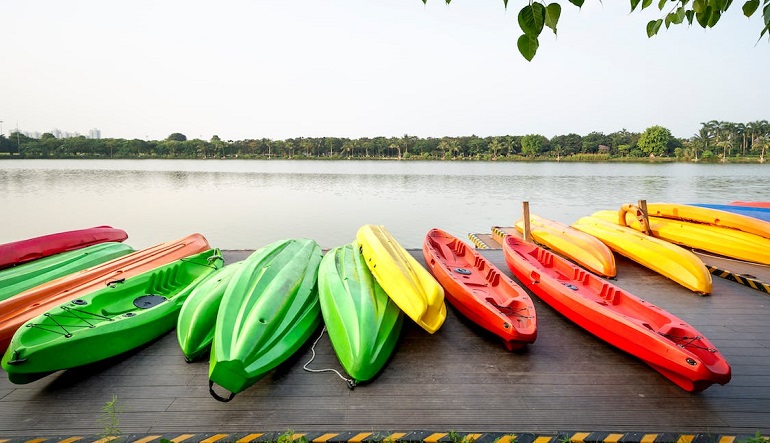
7. Outdoor
This is one of the best places to store your kayak. If you can’t do that, you can store it outside, but there are a few things you need to keep in mind.
First, put your boat away somewhere covered. The best spot is one that is dry, free of bugs and rodents, and out of the way of kids and cars. Second, make sure the area is stable enough to support the weight of the kayak without falling over or hurting you or your boat.
When you store your kayak outside, it’s very important that it’s somewhere that stays cool. The sun can weaken the materials that were used to make your kayak, which can lead to cracks and fading. Parts made of plastic can also break easily.
You can also add UV protection with a strong sun protection spray if you store it outside in the right way.
8. Indoor
Anywhere inside, like a garage or basement, is the best place to keep your boat. If neither of those options works, you could rent a place to store your kayak. It needs to be kept out of direct sunshine because UV rays can damage it over time.
Plastics are also damaged by sudden changes in temperature, so try not to store your kayak in places that get very hot or very cold (like next to a radiator or heater vent) or where the temperature changes a lot.
When deciding how to keep a kayak or a canoe, it’s important to remember that plastic kayaks should be kept on their sides and canoes should be kept upside down.
That’s it for now. Next, let’s talk about another very important rule for storing kayaks.
A boat isn’t the most fragile thing you own, but you should still take care of it. You could put your kayak at risk if you store it in a place that doesn’t have good airflow or direct sunlight.
Shiny things can hurt the surface of your boat, its deck, and things that are easily broken. Extreme heat can damage the foam core of the kayak, and moisture can make it rust.
If you want to store your kayak for a long time, keep it straight in a dry, well-ventilated space. Put it under a tarp or cover if you have to store it outside. It’s also best to bring the boat inside during heavy rain so that water doesn’t damage it.
Hardshell kayaks are better for protecting your kayak from damage, but inflatable kayaks are easier to store and move because they are smaller and lighter.
9. Keep the Kayak off Hard Surfaces
The rule needs its own section, right? Setting your kayak on a firm, flat surface and waiting to use it again is tempting. In essence, what may happen?
Don’t put your kayak on the ground, even with cushioning, if you store it in a garage or basement. This can damage the hull and cockpit, requiring costly repairs or boat replacement.
Vertical storage prevents water from pooling around your kayak and corroding its parts. Leave two or three inches between your boat and walls or ceilings.
If size limits prevent this, make sure there are no gaps between your boat and the floor/wall (including mounting brackets).
Keep your kayak upside down to avoid water gathering in the hull. Put your kayak on a rack or saw horses to raise it a few feet. This improves airflow and prevents mold. Kayak racks can be bought or built.
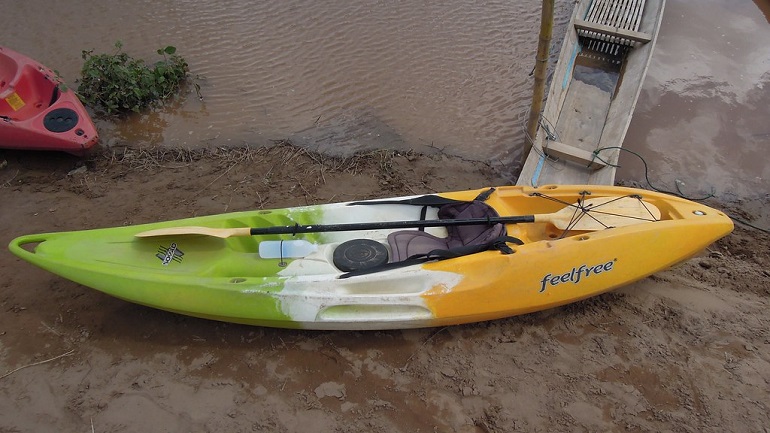
10. Kayak Storage Options
The lack of storage space frustrates us all. This is especially true for kayakers! Luckily, there are several ways to store your kayak without taking up much space, whether it’s a leisure or river fishing kayak.
A storage rack is the ideal way to store kayaks indoors or outside. Let’s discuss your outdoor and indoor kayak storage options.
Outdoor Storage Options
Using an outdoor place for your kayaks gives you several alternatives.
If you want to store your kayak outside, you need a structure, thus some of the following solutions may seem like indoor ones:
- Carport: A carport is a smaller garage for vehicles or motorcycles.
- Covered porch: If you live in a rainy climate with warm summers, a covered porch may provide additional shelter from rain and sun.
- Boathouse: Boathouses are usually isolated from major buildings on a property and used to store boats.
- Sheds: Sheds are another kayak storage option. It is a smaller boat house or outbuilding.
Indoor Storage Options
If you don’t have enough space outside, consider storing your kayak indoors. Indoor storage is recommended for kayaks.
Ideas for indoor storage:
- Garage: One of the most typical kayak storage locations. Build a kayak storage area in your garage or outside if you need more space.
- Basement: The basement is another option for kayak storage, but it must be dry and well-ventilated.
- Rental storage: If your home is too small, consider renting a storage unit. Make sure the building has security cameras and an alarm. Many institutions have 24/7 surveillance to dissuade thieves.
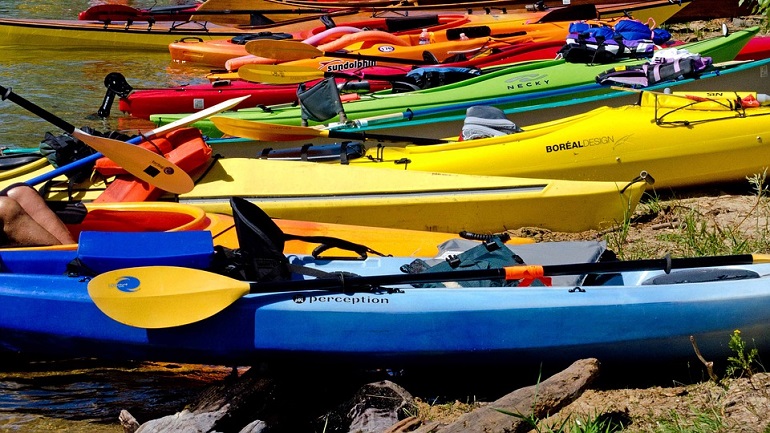
Prevention of theft
You may store a kayak in many ways; just pick the one that works best for you. After choosing the best kayak storage solution, consider theft protection if you don’t want your kayak stolen.
There are numerous theft protection systems, some more secure than others.
- Locking cables, are lengthy cords you wrap around your kayak. The most frequent approach to protect your kayak at home or in transit is this.
- Lockable racks, available in hard-shelled and soft-sided versions, offer two security advantages over tie-down straps:
- Their purpose is to deter theft and secure tie-downs and other gear.
- Many are locked to prevent theft and tampering during storage (if left out). You can also use the finest truck racks for kayaks for transit.
Locks for boats themselves (fiberglass vs. plastic): Boat locks (fiberglass vs. plastic): Most fiberglass boats come with manufacturer-installed locks (sometimes requiring specialized keys), but plastic boats rarely do.
Conclusion
I hope you learned something new about kayak storage and can choose the best indoor or outdoor solution.
I recommend always keeping your kayak clean and dry after finding adequate storage. If possible, store your kayak indoors to avoid theft and solar damage, but there are other possibilities.
I recommend keeping your kayak upside-down on saw horses for maximum protection. These easy-to-assemble racks can be bought online or at hardware stores.





